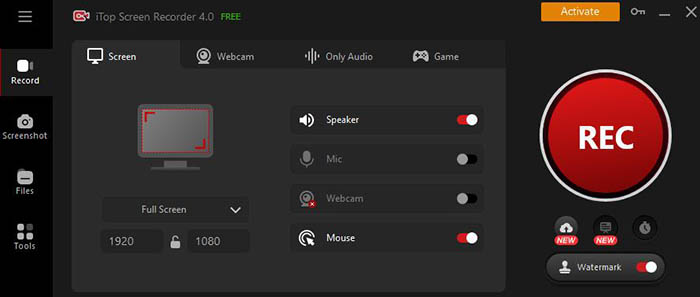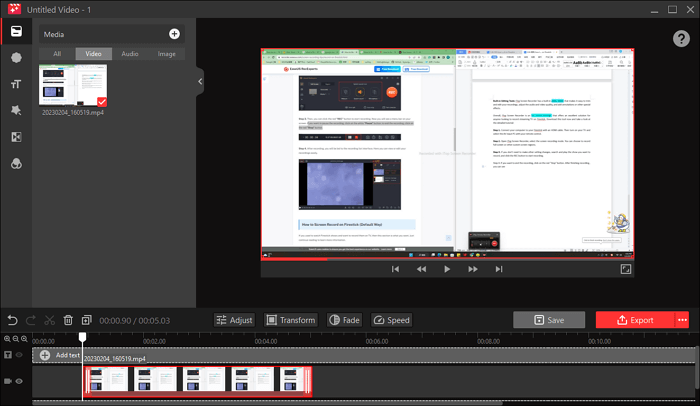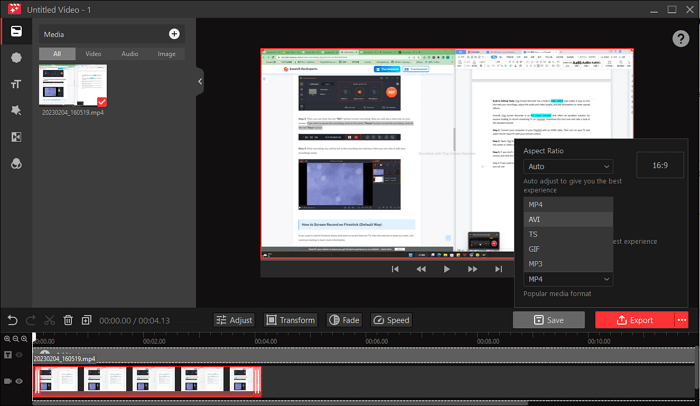Instructional videos have become an immensely popular medium for teaching and learning. Whether you're a teacher, trainer, content creator, or simply someone with valuable knowledge to share, instructional videos can be a powerful tool to engage your audience and convey information in a clear and compelling manner.
This article will equip you with comprehensive guides and tips about how to make instructional videos step by step. We will also show you techniques to make your instructional videos more interesting and engaging, ensuring your audience stays captivated throughout.

So, What Are Common Types of Instructional Videos?
First of all, you should make it clear how many types of instructional videos are there. Having a thorough understanding of the basic information about instructional videos can help you decide what kind of videos you should make. Here are some common instructional videos ideas.
1. Microvideos
Microvideos are known as short videos. They are now popular on SNS platforms such as Tik Tok and Instagram. These short instructional videos focus on delivering bite-sized pieces of information. Usually ranging from 15 to 60 seconds, they are perfect for quick tutorials, tips, or engaging snippets that provide concise and specific knowledge.
2. Screencasts
Screencasts are instructional videos that capture the screen activity of a computer or mobile device. They are commonly used to demonstrate software usage, walkthroughs, or step-by-step processes, allowing viewers to follow along and learn by observing the actions on the screen.
3. Explainer videos
Explainer videos use visual effects, animation, and narration to simplify complex concepts or ideas. They break down complex topics into easily understandable chunks, employing storytelling techniques to engage the audience and ensure a clear understanding of the subject matter.
4. Tutorial videos
Compare with the formerly mentioned three types of videos, a tutorial video will be much longer. Those videos are comprehensive guides that teach viewers how to perform specific tasks or acquire new skills. They provide detailed step-by-step instructions, often with demonstrations, to enable viewers to learn and replicate the process effectively.
5. Training videos
Training videos are designed to educate individuals on a particular subject or skill. They are commonly used in corporate training, employee onboarding, or educational programs. Training videos ensure consistent delivery of information and allow learners to access the material at their convenience.
6. Lecture videos
Lecture videos capture presentations or lectures given by subject matter experts or instructors. They are typically longer in duration and cover in-depth topics, providing a structured learning experience. Lecture videos are often utilized in online courses, academic settings, or professional development programs.
How to Make Instructional Videos - Step by Step
After exploring the different types of instructional videos, it’s time to start the process of creating a compelling instructional video. The steps here cover from planning and scripting to recording and editing videos, you will know each stage of the video production process, equipping you with the knowledge and tools necessary to create professional-quality instructional videos. Here are the steps on how to make instructional videos:
Step 1. Plan Your Video Content
To ensure a well-structured and engaging instructional video, careful planning is essential. You can start by defining learning objectives and identifying the key concepts of your video.
Creating an outline or script tells the flow of your video, including the introduction, main sections, and conclusion. You can also think about whether to add visual aids, demonstrations, or examples to enhance this instructional video.
Step 2. Build Video-Ready Slides
Once you have a clear plan for your instructional video, it's time to create visually appealing slides that complement your content. Utilize visual cues, animations, and graphics to enhance understanding and engagement. You should use as less text as possible and focus on delivering information through visual elements to make your video easier to follow.
Step 3. Record Your Audio and Screen
To bring your instructional video to life, you'll need a reliable screen recording tool. One such tool is iTop Screen Recorder, if you want to know how to make instructional videos with screen recording, it is an excellent choice.
Key features of iTop Screen Recorder include:
- Record Any Part of Screen. Capture specific areas or the entire screen, allowing you to focus on the relevant content.
- Capture Webcam and Mic. Easily integrate your webcam and microphone to add a personal touch and provide voiceover explanations.
- HD Video Quality. Ensure your instructional videos are crystal clear with high-definition video recording capabilities.
- Video and Audio Editing. Fine-tune your recordings with video and audio editing features, allowing you to trim, crop, and enhance your content.
With such a screen recording tool, you can record the demonstration slides on your computer, and capture your voice at the same time.

Step 4. Edit the Video
After recording the demonstration process, the next step of how to make instructional videos is to refine it through the editing process. With iTop Screen Recorder's built-in video editing feature, you have a range of options to enhance your video. Trim, cut, or splice segments to remove any unwanted parts. Add effects, transitions, annotations, or quizzes to make your video more engaging and interactive.

Step 5. Export and Share the Video
Once you've completed editing your instructional video, it's time to export and share it with your intended audience. iTop Screen Recorder allows you to export your video in various formats and resolutions, making your video compatible with different platforms and devices. Share your video on video hosting sites, or social media, or embed it in presentations or websites to reach your target viewers and share your knowledge.

Make Your Instructional Videos Interesting and Engaging - 6 Tips
A long and dull instructional video must be the last thing you want. The key to a successful instructional video is to be both entertaining and thought-provoking. If you want to know how to make instructional videos interesting, check the given tips here.
1. Tell a story
Adding storytelling elements into your instructional videos can help to keep the viewers better engaged throughout the content. Use relatable examples, anecdotes, or scenarios to make the information more memorable and relatable.
2. Use visuals to support your verbal explanations
Using visual aids such as diagrams, charts, or illustrations can enhance understanding and reinforce your verbal explanations. Utilize on-screen annotations, graphics, or animations to visualize key concepts of your video and make it more engaging.
3. Humor is always the icing on the cake
Incorporating a bit of humor into your instructional videos can make it more enjoyable and memorable for your audience. Use light-hearted jokes, witty comments, or fun visuals to create a positive and entertaining learning experience.
4. Increase interactivity
Include interactive elements in instructional videos to encourage audience participation. These interactive elements include quizzes, polls or interactive exercises that actively engage the audience to help them better understand the teaching content.
5. Guide your viewers properly
To ensure clarity and coherence, effectively guide your audience through your instructional video. Use transitions, summaries, or previews to help viewers follow your logic and structure, making it easier for them to grasp and remember information.
6. Accessibility
Make your instructional videos accessible to a wider audience by adding closed captions or subtitles. This enables viewers who are hard of hearing or have no sound to follow along. Also, consider providing transcripts or supplemental materials for further access and reference.
Make Instructional Videos - FAQs
1. What equipment do I need to make instructional videos?
You’ll need a computer or mobile device with a reliable screen recording tool, a microphone for clear audio, and a webcam for a personal touch. Additionally, good lighting and a quiet environment can enhance the overall quality of your video.
2. How long should an instructional video be?
The ideal length of an instructional video depends on the complexity of the topic and the attention span of your target audience. In general, it is recommended to keep instructional videos between 3 and 10 minutes to keep viewers engaged and to deliver content concisely.
3. Can I make money with instructional videos?
Yes, instructional videos can be monetized through various means. You can leverage platforms like YouTube to earn revenue from ads or explore creating premium courses or memberships to generate income. Additionally, instructional videos can help establish your expertise, leading to opportunities for consulting, speaking engagements, or product sales.
4. What software is used to make instructional videos?
There are several software options available for making instructional videos. iTop Screen Recorder, Camtasia, Adobe Captivate, and OBS Studio are popular choices. These tools offer features like screen recording, video editing, and audio manipulation, allowing you to create professional-quality instructional videos.
5. What makes a good instructional video?
A good instructional video can effectively convey intended information, engage viewers, and facilitate learning. It should have a clear structure, concise explanations, relevant visuals, and a logical flow. Engaging narration, presentation, and interactive elements enhance audience understanding and retention of content.
Conclusion
With the steps outlined in this guide, you will know how to make instructional videos thoroughly. From planning and recording to editing and sharing, each stage plays a crucial role in delivering an engaging learning experience. A handy screen recording tool like iTop Screen Recorder will help you make the creation process more efficient. This screen recorder also offers video editing features to empower you to polish your instructional video to perfection. Download it and have a try now!
 Vidnoz AI creates engaging videos with realistic AI avatars. Free, fast and easy-to-use.
Vidnoz AI creates engaging videos with realistic AI avatars. Free, fast and easy-to-use.














